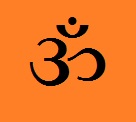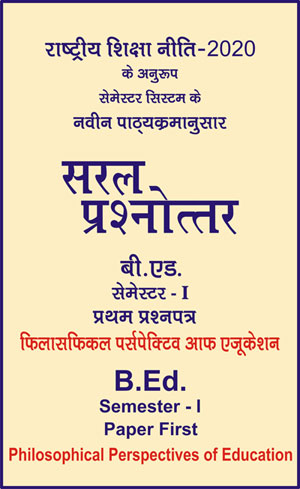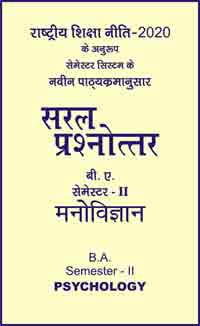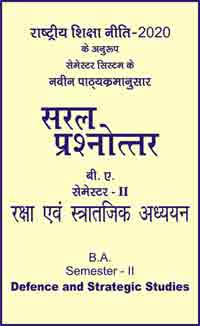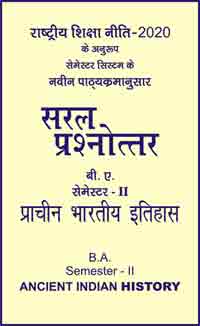|
बी एड - एम एड >> बी.एड. सेमेस्टर-1 प्रश्नपत्र-I - फिलासफिकल पर्सपेक्टिव आफ एजुकेशन बी.एड. सेमेस्टर-1 प्रश्नपत्र-I - फिलासफिकल पर्सपेक्टिव आफ एजुकेशनसरल प्रश्नोत्तर समूह
|
5 पाठक हैं |
|||||||
बी.एड. सेमेस्टर-1 प्रश्नपत्र-I - फिलासफिकल पर्सपेक्टिव आफ एजुकेशन (अंग्रेजी भाषा में)
OBJECTIVE TYPE QUESTIONS
Unit - I: Education and Agencies of Education
-
What is the meaning of Education?
(a) Schooling
(b) Training
(c) Development
(d) Liberation -
What is Education?
(a) Education is that which teachers give
(b) Education is a book
(c) Education is total development of personality
(d) Education is that which provides job -
What are the part of Education?
(a) Teacher
(b) Learner
(c) Curriculum
(d) All these -
Which is the universal objective of Education?
(a) Liberation
(b) Vocation
(c) Character
(d) Total Development -
Which is the all-time objective of Education?
(a) Earning livelihood
(b) Becoming a good citizen
(c) Developing character
(d) All round achievement -
Who will pay for Basic Education?
(a) The Govt
(b) The people
(c) The Scheme
(d) The parents -
What is the medium of instruction in Basic Education?
(a) Hindustani
(b) Hindi
(c) Urdu
(d) English -
What is central in Basic Education?
(a) The Teacher
(b) The Educand
(c) Basic craft
(d) Language -
The component of education is the:
(a) Objectives
(b) Curriculum
(c) Methods
(d) All the above -
Aims of education are relative to:
(a) Aim of religion
(b) Aim of teacher
(c) Aim of life
(d) Aim of government -
Which of the following statement is correct?
(a) Education is an art
(b) Education is a science
(c) It is neither an art nor science
(d) It is an art and a science -
The aim of education for harmonious development of the child means:
(a) Development of all the qualities of the mind to the maximum possible extent.
(b) Development of a sound mind in a sound body.
(c) Development of physical, mental and moral potentialities of the child.
(d) Development of the adjustment capacities of the child. -
What is development of human potentialities in education?
(a) Individual aim
(b) Social aim
(c) Individual as well as social aim
(d) Specific aim -
Which is the first school for the child’s education?
(a) Family
(b) Society
(c) Friend
(d) School -
What is the origin of the word Education?
(a) ‘E’ and ‘Catum’
(b) Edu and ‘Catum’
(c) Word ‘Educate’
(d) None of these -
Which of the following statements is correct?
(a) Education is an art
(b) Education is a science
(c) It is neither an art nor science
(d) To some extent it is art and to some extent it is science -
What is called education acquired without any specific purpose, fixed period and place?
(a) Indirect Education
(b) Individual Education
(c) Informal Education
(d) Formal Education -
Which one of the following sentences is correct about the nature of teaching?
(a) It is diagnostic
(b) It is remedial
(c) It is diagnostic as well as remedial
(d) All the above statements are correct -
What is the compulsory element of learning?
(a) Ability to read
(b) Bright Mind
(c) Tendency to know
(d) None of these -
What is the place of principal in an educational institute?
(a) Overall head of the school
(b) Manager of the school
(c) Owner of the school
(d) Founder of the school -
If a student failed in any class what should be done to him?
(a) He should be given a chance to improve and sent to the next class after he improves
(b) He should be kept in the same class
(c) He should be advised to leave studies
(d) All the above methods are right -
Why are curriculum activities used in teaching?
(a) Make teaching easy
(b) To make teaching interesting, easy to understand and effective
(c) To make teaching attractive
(d) To assist the teacher -
What are the three components of the educational process?
(a) Education, teacher and books
(b) Teacher, student and education
(c) Teaching, learning and practice
(d) Direction, instruction and skill -
What is teaching through deductive method?
(a) From general to specific
(b) From specific to general
(c) From macro to micro
(d) From easy to difficult -
What is the main center of informal Education?
(a) Society
(b) Family
(c) Radio and Television
(d) All of the above -
Which is the first school for a child’s education?
(a) Society
(b) Friends
(c) Family
(d) School -
Which one of the following education systems supports scientific progress?
(a) Realistic Education
(b) Idealistic Education
(c) Naturalistic Education
(d) None of these -
What is the meaning of lesson plan?
(a) To read the lesson before teaching it
(b) To prepare all that the teacher wants to teach in a limited period
(c) To prepare detailed Answer -s of all the questions to be asked in the class
(d) To prepare the list of questions to be asked -
What is the view point of progressive educators regarding the issue of liberal vs. vocational education?
(a) Vocational ends lead one to degrade learning
(b) Liberal arts subject should proceed vocational training
(c) Vocational and liberal education should not be separated
(d) All subjects should have a vocational orientation -
What do you mean by curriculum?
(a) A child learns through curriculum
(b) Sum total of the annual study
(c) Sum total of the activities of a school
(d) Indicates the course to be taught by the teachers to the students throughout the year -
The Realist’s aim of education is:
(a) Self-realization
(b) Spiritual and moral development
(c) Happy and moral development
(d) Total development of personality -
Which of the following is more generally acceptable by modern educationists?
(a) There should be one single aim of education unchangeable over time and space
(b) There is one grand objective of education; and that is the development of the inner nature of the child
(c) Contribution to the welfare of the society should be the only aim of education
(d) Education is bound to have several aims since its concerns are several such as the individual, the society, the family, the nation and so on -
What is development of human potentialities in education?
(a) Individual aim
(b) Social aim
(c) Individual as well as social aim
(d) Specific aim -
What is development of social sense and cooperation among the individuals through education?
(a) Individual aim
(b) Social aim
(c) National aim
(d) Constitutional aim -
Which among the following is not an acceptable criticism of social aims of education?
(a) They are anti-individual
(b) They are un-psychological as they do not take into account the capacities and interests of the individual
(c) They hinder the growth and development of art and literature
(d) Man, in them, becomes only a means to an end -
Which among the following is not emphasized by the individual aims of education?
(a) Individual freedom
(b) Self-expression
(c) Development of inner potentialities
(d) Development of values of tolerance and non-violence -
Which of the following statements does not go in favour of the individual aims of education?
(a) The individual is an asset to the society; his development and growth are necessary
(b) The society is strong if the individual is strong
(c) Every individual is unique; development of his potentialities is essential
(d) Society is supreme and all individuals are only parts of it -
Which among the following is the most correct view about social and individual aims of education?
(a) Individual aims should be given preference to social aims
(b) Social aims should be preferred to individual aims
(c) Individual aims are implied in the social aims of education
(d) Individual and social aims are only two sides of the same coin -
Which statement is most acceptable to the academicians about “Bread and butter aim” of education?
(a) It is the most important aim and should be given top priority by educationists
(b) It is equally important along with other aims of education
(c) It is only partly acceptable
(d) It is important for only a section of the society -
Which of the following does not pertain to intellectual development aim of education?
(a) Cultivation of intelligence
(b) Spiritual development
(c) Development of cognitive powers
(d) Training and “formation” of mind -
Preparing the child for future life as an aim of education is preparing child for:
(a) Some suitable vocation
(b) Some particular course of study
(c) Facing all kinds of emergencies and situations of future life
(d) A happy married life -
The most effective method of character-formation is:
(a) Teaching virtues through religious books
(b) Organizing specialists’ lectures on importance of values in life
(c) Teaching by high character teachers
(d)Rewarding virtuous behaviours and presenting high character model in schools -
Harmonious development of the child aim of education means:
(a) Development of all the qualities of the mind to the maximum possible extent
(b) Development of a sound mind in a sound body
(c) Development of physical, mental, moral and spiritual potentialities of the child in a balanced manner
(d) Development of the adjustment capacities of the child -
The social aims of education imply that:
(a) The state is an idealized metaphysical entity
(b) The state is above the individual citizen
(c) The state is superior to the individual transcending all his desires and aspirations
(d) The state has to give not to take anything from the individual -
Rigid system of state-education is justified on the basis that the state:
(a) Is supreme to dictate what shall be taught and how shall be taught
(b) Has absolute control over the lives, and destinies of its individual members
(c) Has a right and a bounden duty to mould the citizen to a pattern which makes for its own preservation and enhancement
(d) Has better resources to manage education -
Social aims of education imply the training of:
(a) The individuals for the purpose of serving the needs of the society
(b) Individuals according to their needs
(c) The individuals according to their capacities
(d) The individuals according to the facilities -
What does the individual aim of education imply?
(a) Education must secure for everyone the conditions under which the individuality is most completely developed
(b) It must contribute to the peace and happiness of the whole society
(c) It should have more and more institutions every year
(d) It should be by and large the concern of the private sector -
Basically Education is derived from a Latin word:
(a) Ducer
(b) Doctrine
(c) Educate
(d) Educere -
What does mean by Educere:
(a) Path
(b) Destination
(c) Bring out
(d) Guide -
What does mean by Pragma:
(a) Practical
(b) Thinking
(c) Both (a) and (b)
(d) None of the above -
What should be the goal of education?
(a) Training to make a living
(b) Acquiring knowledge, skills, habits
(c) Getting a certificate
(d) Mastery of subject matter -
What does mean by Education?
(a) Change in behaviour
(b) Behaviour
(c) Change
(d) Experience -
The knowledge relates to values is called:
(a) Axiology
(b) Epistemology
(c) Ontology
(d) Metaphysics -
To have an aim is to act, means:
(a) Want to do something
(b) To be an automatic machine
(c) To perceive the meaning of things in that light
(d) Both (b) and (c) -
The chief aim of education shall be to help the growing soul to draw out that in itself which is best and make it perfect for a noble use according to:
(a) Moral aim
(b) Spiritual aim
(c) Religious aim
(d) Social aim -
The pressure is felt strong where by the teacher?
(a) Large number of children to educate
(b) Form global government
(c) Making religion strong
(d) Large number of adults to educate -
"Education as a force which makes an individual self reliant as well as selfless." The statement related:
(a) Rig Veda
(b) Sam Veda
(c) Vedanta
(d) Upanishad -
"Social aim of education" was stressed in:
(a) Developed Countries
(b) North America
(c) Developing Countries
(d) All of the above -
Which is the most important element of non-formal education?
(a) Student
(b) Media
(c) School
(d) Teacher -
Generally sociological aims of education include:
(a) Skills
(b) Dutifulness
(c) Cultural growth
(d) All of the above -
Generally civic aims of education include:
(a) Dutifulness
(b) Venture
(c) Skills
(d) Civic sense -
Which is a descriptive definition of the term is its:
(a) Reason
(b) Justification
(c) Validation
(d) Explanation -
In the classroom the emphasis should be on:
(a) The subject matter
(b) The teaching method
(c) The needs of an individual child
(d) Needs of the whole class -
Which is the basic source of educational objectives?
(a) Educational psychology
(b) State legislatures
(c) Human experiences
(d) Professional organization -
What should be the objective of any school subject?
(a) Determined by subject matter
(b) The basis for content and class activities
(c) Teacher derived
(d) General in nature -
The best definition of education is:
(a) Learning
(b) Growth resulting from experiences
(c) Acquiring knowledge
(d) Preparation for life -
Generally Lecture method is a choice of:
(a) Realist teacher
(b) Idealist teacher
(c) Both (a) and (b)
(d) None of the above -
Experimental knowledge is real, who believes:
(a) Essentialism
(b) Progressivism
(c) Reconstruction
(d) Perennialism -
Logical and scientific thinking mostly includes:
(a) Orderly knowledge
(b) Value system
(c) Orderly philosophy
(d) Orderly thinking -
Through which way authentic knowledge is gained:
(a) Institution
(b) Empirical experiences
(c) Authority
(d) All of the above -
Basically an elective is one who:
(a) Denies it is possible to know the reality
(b) Takes a belief from several philosophies
(c) Believes in the existence of universals
(d) Rejects all philosophies positions -
In which education plays a vital role:
(a) Promoting national integration
(b) Character formation
(c) Promoting social reforms
(d) All of the above -
Each system of education is based upon:
(a) Social and civil obligation
(b) Intellectual development
(c) Ideology of nation
(d) None of the above -
From the following which one is the requirement of a discipline?
(a) Curriculum theory
(b) A set of related assumptions
(c) Body knowledge
(d) None of the above -
The main aim of liberal education is:
(a) Promotion of internationalism
(b) Fullest development of the individual
(c) The attainment of freedom
(d) All of the above -
Democracy basically does not believe in:
(a) Tolerance
(b) Non-violence
(c) Small family
(d) Secularism -
The realist’s aim of education is basically:
(a) Happy and moral development
(b) Total development of personality
(c) Self-realization
(d) Spiritual and moral development -
According to idealism the main aim of education is to develop:
(a) Mind and soul
(b) Soul and body
(c) Body
(d) Soul -
To seek truth and reality is basically the subjects of:
(a) Morals
(b) Hermeneutics
(c) Philosophy
(d) Education -
Generally the essentialist philosophy of education is:
(a) Content and child-centered
(b) Content and teacher-centered
(c) Need-centered
(d) Society centered -
From the following who says “Permanency is more real than change”:
(a) Reconstructionism
(b) Progressivism
(c) Essentialism
(d) Perennialism -
The type of knowledge that is basically derived from senses is known as:
(a) Logical
(b) Empirical
(c) Revealed
(d) Rational -
From the following who says education is life itself not a preparation for life:
(a) Reconsturctism
(b) Progressivism
(c) Essentialism
(d)perennialism -
Usually the expected life outcomes from education are referred to as:
(a) Aims of education
(b) Objectives of education
(c) Goals of education
(d) None of the above -
Generally philosophy may be prescriptive and:
(a) Analytical
(b) Critical
(c) Normative
(d) Speculative -
Generally the nature of scientific knowledge rests on:
(a) Repetition
(b) Empiricism
(c) Experimentation
(d) All of the above -
Education as the re-organization of experience is basically expounded by:
(a) John Locke
(b) Rousseau
(c) John Dewey
(d) William James -
From the following which statement is correct?
(a) It is neither an art nor science
(b) To some extent it is an art and to some extent it is science
(c) Education is a science
(d) Education is an art -
What does mean by curriculum?
(a) Sum total of the annual study
(b) Sum total of the activities of a school
(c) Indicates the course to be taught
(d) A child learns through curriculum -
The main center of informal education is:
(a) Family
(b) Radio and Television
(c) Society
(d) All of the above -
The compulsory element of learning is:
(a) Bright Mind
(b) Tendency to know
(c) Ability to read
(d) None of the above -
The first school for a child’s education is:
(a) Friends
(b) Family
(c) School
(d) Society -
The scope of education according to the idealist is:
(a) Arrangement of education should be voluntary
(b) Only they deserve educations that are spiritual
(c) Education is meant for idealists only
(d) Education should be compulsory -
From the following, which sentence is correct about the nature of teaching?
(a) It is diagnostic as well as remedial
(b) It is diagnostic
(c) It is remedial
(d) All of the above are correct -
Education imparted in schools is basically:
(a) Traditional
(b) Standardize
(c) Informal
(d) Formal -
In an educational institution the place of the principal is as:
(a) Founder of the school
(b) Owner of the school
(c) Manager of the school
(d) Overall head of the school -
The purpose of using curriculum activities in teaching is to:
(a) Make teaching attractive
(b) Make teaching interesting, easy to understand, and effective
(c) Assist the teacher
(d) Make teaching easy -
The three components of the educational process are:
(a) Teaching, Learning, and practice
(b) Direction, instruction, and skill
(c) Teacher, student, and education
(d) Education, teacher, and books -
What is the origin of the word Education?
(a) Word 'Educate'
(b) Edu and 'Catum'
(c) 'E' and 'Catum'
(d) None of these -
Which of the following statements is correct?
(a) Education is an art
(b) Education is a science
(c) It is neither an art nor science
(d) To some extent it is art and to some extent it is science -
What is called education acquired without any specific purpose, fixed period and place?
(a) Formal Education
(b) Informal Education
(c) Indirect Education
(d) Individual Education -
Which one of the following sentences is correct about the nature of teaching?
(a) It is remedial
(b) It is diagnostic
(c) It is diagnostic as well as remedial
(d) All the above statements are correct -
What is the compulsory element of learning?
(a) Tendency to know
(b) Ability to read
(c) Bright Mind
(d) None of these -
What is the place of principal in an educational institute?
(a) Owner of the school
(b) Founder of the school
(c) Manager of the school
(d) Overall head of the school -
If a student failed in any class what should be done to him?
(a) He should be kept in the same class
(b) He should be advised to leave studies
(c) He should be given a chance to improve and sent to the next class after he improves
(d) All the above methods are right -
Why are curriculum activities used in teaching?
(a) To assist the teacher
(b) Make teaching easy
(c) To make teaching attractive
(d) To make teaching interesting, easy to understand and effective -
What are the three components of the educational process?
(a) Direction, instruction and skill
(b) Teaching, learning and practice
(c) Teacher, student and education
(d) Education, teacher and books -
What is teaching through deductive method?
(a) From easy to difficult
(b) From macro to micro
(c) From general to specific
(d) From specific to general -
What is the main centre of informal Education?
(a) Society
(b) Family
(c) Radio and Television
(d) All of the above -
Which is the first school for a child's education?
(a) School
(b) Family
(c) Friends
(d) Society -
Which one of the following education systems supports scientific progress?
(a) Naturalistic Education
(b) Idealistic Education
(c) Realistic Education
(d) None of these -
What is the meaning of lesson plan?
(a) To read the lesson before teaching it
(b) To prepare the list of questions to be asked
(c) To prepare all that the teacher wants to teach in a limited period
(d) To prepare detailed Answer -s of all the questions to be asked in the class -
What is the view point of progressive educators regarding the issue of liberal vs. vocational education?
(a) Vocational ends load one to degrade learning
(b) All subjects should have a vocational orientation
(c) Liberal arts subject should proceed vocational training
(d) Vocational and liberal education should not be separated -
What do you mean by curriculum?
(a) Sum total of the annual study
(b) A child learns through curriculum
(c) Sum total of the activities of a school
(d) Indicates the course to be taught by the teachers to the students throughout the year -
Which is not Naturalism’s aim of Education?
(a) To inculcate ethical and moral values in the pupils
(b) Education is the notion of man’s evolution from lower forms of life
(c) To equip the individual or the nation for the struggle for existence so as to ensure survival
(d) To help the pupils to learn to be in harmony with and well-adapted to their surroundings -
The aim of education according to the Existentialists is:
(a) Objective knowledge
(b) Adaptation to practical life
(c) A good understanding of the world outside
(d) Humanitarian and humanist self-realization -
The Realist’s aim of education is:
(a) Self-realization
(b) Happy and moral development
(c) Spiritual and moral development
(d) Total development of personality -
Which among the following is not essentially desirable in the project method?
(a) The task of the project should be full of message for the children
(b) The task of the project is as real as the task of the life outside the walls of the school
(c) The task of the project involves constructive effort or thought yielding objective results
(d) The task of the project should be interesting enough so that the pupil is genuinely eager to carry it out -
Which of the following is more generally acceptable by modern educationists?
(a) Contribution to the welfare of the society should be the only aim of education
(b) There should be one single aim of education unchangeable over time and space
(c) There is one grand objective of education; and that is the development of the inner nature of the child
(d) Education is bound to have several aims since its concerns are several such as the individual, the society, the family, the nation and so on -
What is development of human potentialities in education?
(a) Social aim
(b) Specific aim
(c) Individual aim
(d) Individual as well as social aim -
What is development of social sense and cooperation among the individuals through education?
(a) Social aim
(b) Individual aim
(c) National aim
(d) Constitutional aim -
Which among the following is not an acceptable criticism of social aims of education?
(a) They are anti-individual
(b) Man, in them, becomes only a means to an end
(c) They hinder the growth and development of art and literature
(d) They are un-psychological as they do not take into account the capacities and interests of the individual -
Which among the following is not emphasized by the individual aims of education?
(a) Self-expression
(b) Individual freedom
(c) Development of inner potentialities
(d) Development of values of tolerance and non-violence -
Which of the following statements does not go in favour of the individual aims of education?
(a) The society is strong if the individual is strong
(b) Society is supreme and all individuals are only parts of it
(c) Every individual is unique; development of his potentialities is essential
(d) The individual is an asset to the society; his development and growth are necessary -
Which among the following is the most correct view about social and individual aims of education?
(a) Social aims should be preferred to individual aims
(b) Individual aims are implied in the social aims of education
(c) Individual aims should be given preference to social aims
(d) Individual and social aims are only two sides of the same coin -
Which statement is most acceptable to the academicians about "Bread and butter aim" of education?
(a) It is only partly acceptable
(b) It is important for only a section of the society
(c) It is equally important along with other aims of education
(d) It is the most important aim and should be given top priority by educationists -
Which of the following does not pertain to intellectual development aim of education?
(a) Spiritual development
(b) Cultivation of intelligence
(c) Training and "formation" of mind
(d) Development of cognitive powers -
Preparing the child for future life as an aim of education is preparing the child for:
(a) Some suitable vocation
(b) A happy married life
(c) Some particular course of study
(d) Facing all kinds of emergencies and situations of future life -
The most effective method of character formation is:
(a) Teaching by high character teachers
(b) Teaching virtues through religious books
(c) Organizing specialists' lectures on importance of values in life
(d) Rewarding virtuous behaviours and presenting high character models in the schools -
Harmonious development of the child aim of education means:
(a) The state is above the individual citizen
(b) The state is an idealized metaphysical entity
(c) The state has to give not to take anything from the individual
(d) The state is superior to the individual transcending all his desires and aspirations -
Rigid system of state-education is justified on the basis that the state:
(a) Has better resources to manage education
(b) Is supreme to dictate what shall be taught and how shall be taught
(c) Has absolute control over the lives, and destinies of its individual members
(d) Has a right and a bounden duty to mould the citizen to a pattern which makes for its own preservation and enhancement -
Social aims of education imply the training of:
(a) Individuals according to their needs
(b) The individuals according to the facilities
(c) The individuals according to their capacities
(d) The individuals for the purpose of serving the needs of the society -
What does the individual aim of education imply?
(a) It should have more and more institutions every year
(b) It should be by and large the concern of the private sector
(c) It must contribute to the peace and happiness of the whole society
(d) Education must secure for everyone the conditions under which the individuality is most completely developed -
The social aims of education imply that:
(a) The state is above the individual citizen
(b) The state is an idealized metaphysical entity
(c) The state has to give not to take anything from the individual
(d) The state is superior to the individual transcending all his desires and aspirations -
Evaluate the viewpoint "The child knows better than any educator what he should learn, when and how he should learn it"?
(a) Practical, but not correct
(b) Correct, but not practical
(c) Correct and practical both
(d) Hundred percent correct -
In evolution self aims at:
(a) Liberation
(b) Enjoyment
(c) All of the above
(d) None of these -
In Democracy educational pattern is planned after the interests of the many because:
(a) There are always too many illiterates in a democracy
(b) Democracy has tremendous faith in her men and their powers
(c) Democracy is the government of the many, by the many and for the many
(d) The ultimate authority determining educational policy in democracy is imminent in man -
Aims of education are determined by human being for the good of the:
(a) Society
(b) Individual
(c) Both (a) and (b)
(d) None of these -
India's constitutional value of "equality of all" is founded on several assumptions. Which of the following is not among these?
(a) Claim of human dignity
(b) All men are alike by nature
(c) All men are created equal
(d) All men have intrinsic worth -
In India's constitutional values equality applied to education means:
(a) To impart same kind of education to all
(b) To impart education to all up to the same level
(c) To have same kinds of institutions for all in the society
(d) To equalize the external or material circumstances of obtaining education -
Which of the following does not contribute to India's national integration?
(a) National language
(b) National curriculum
(c) National system of education
(d) Teaching history compulsorily in the school -
What should be done so that the school is to be the guardian of democracy?
(a) The teachers should have faith in democracy
(b) Democracy should, actually, be lived in the school
(c) Lessons on the importance of democracy should be included in the text-books
(d) Eminent leaders should be invited to school to talk about democracy to teachers and the students -
As one of the Indian constitutional values, secularism means:
(a) No respect for any religion
(b) Abolition of all personal religious laws
(c) Control of religious activities by the government
(d) Equal respect for all religions and no discrimination in any matter on the ground of religion -
For strengthening democracy as a constitutional value through education, it is necessary to ensure that:
(a) People are competitive for progress
(b) People are religious and God-fearing
(c) All people have the freedom to live the life they think is the best for them
(d) People learn large-hearted tolerance, mutual give and take and appreciation of ways in which people differ from one another -
"Child is more important than all kinds of books". This viewpoint of Tagore represents his faith in the following aims of education:
(a) Social aims
(b) Cultural aims
(c) Individual aims
(d) A synthesis of individual and social aims -
"Next to Nature the child should be brought into touch with the stream of social behaviour". By saying this Tagore is trying to emphasize the following aims of education:
(a) Social aims
(b) Individual aims
(c) Both Individual and social aims
(d) Intellectual development aim -
Who said that the aim of education should be to develop in children feelings of international brotherhood and attitude of international understanding?
(a) Dewey
(b) Rousseau
(c) R. N. Tagore
(d) Mahatma Gandhi -
The influence of both philosophy and religion in the life of the human individual and society is: (a) Favorable
(b) Unfavorable
(c) Both (a) and (b)
(d) None of these -
The most important difference between philosophy and science is: (a) Scope
(b) Method
(c) Subject matter
(d) None of these -
Which of the following represents 'communist ideal' of education? (a) Education for Freedom
(b) Education for Nationalism
(c) Education for Democracy
(d) Education for State control
|
|||||




